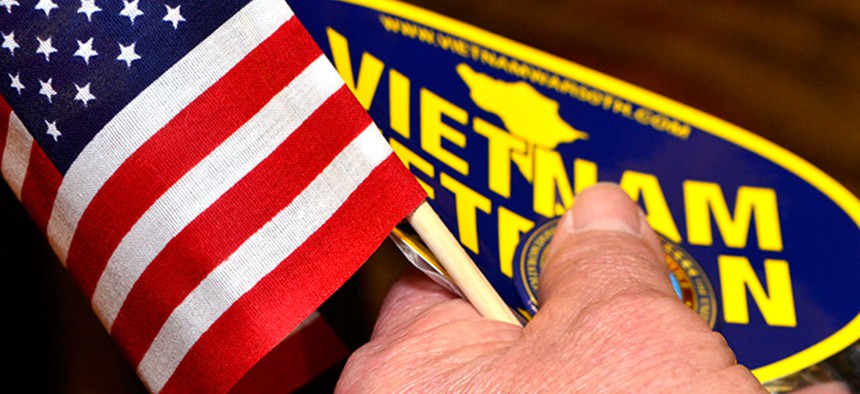
Veterans Affairs file photo
More U.S. Veterans Are Getting Hospice Care
A major push to improve end-of-life care and get more U.S. veterans into hospice appears to be paying off.
Substantially more US veterans are using hospice following a US Department of Veterans Affairs initiative to improve care at the end of life.
The VA wanted to know the effects of its four-year Comprehensive End-of-Life Care (CELC) initiative, which began in 2009.
The findings of a new study, published in Health Affairs, show that the initiative encouraged more hospice use among military veterans, and that the growth outpaced the rate of increase among demographically comparable members of the public receiving Medicare.
Through the initiative, the VA invested in new inpatient hospice units, palliative care staff, palliative care training, and mentoring for leaders and staff, a systematic quality monitoring program, and outreach to community providers outside VA medical centers through the “We Honor Veterans” campaign.
Researchers analyzed the trend in hospice use among more than a million male veterans age 65 and older between 2007 and 2014, and compared the rate of growth with what was happening among hundreds of thousands of demographically similar Medicare beneficiaries not enrolled in VA health care.
“Compared to enrolled veterans’ hospice use in the years before CELC began, their use of hospice after the initiative increased substantially, and rates of increased use were approximately two percentage points higher than the increases observed for Medicare beneficiaries not enrolled in VA health care,” says Susan Miller, a professor of health services, policy, and practice in the School of Public Health at Brown University.
“Based on population data, we estimated that this increase resulted in an additional 17,046 veterans receiving hospice care in fiscal years 2010 to 2014.”
The VA began work to establish a system-wide hospice and palliative care program in 2002.
“Palliative care, in the form of palliative care consults and visits and hospice care, has been found to improve care at the end of life and to result in care more aligned with patient and family preferences,” she says.
“Thus, palliative care results in less aggressive (and undesired) care such as emergency room visits and hospitalizations near the end of life. The VA’s efforts to improve veterans’ end-of-life care arose from the recognition that improvement was needed and the belief that greater access to palliative care and hospice could help to achieve this improvement.”
Over the decade, the VA saw clear growth in hospice use. In 2008, for example, 30 percent of inpatient deaths in VA medical centers were in hospice beds, but by 2011 that proportion had climbed to 44 percent.
During the same timeframe, hospice use had been growing among the general population, too. So researchers structured the study specifically to determine whether the CELC initiative drove growth beyond any trend in the general Medicare population. That wasn’t a simple task given that older veterans are eligible for Medicare as well as VA benefits.
“Some veterans receive care in their last year of life reimbursed by the VA or Medicare or both,” Miller says. “So our evaluation compared differences in changes in hospice use for groups of veterans with differing combinations of health care use.”
The findings show that nonveterans (with Medicare only) increased hospice use by 5.6 percent between the pre-initiative period (fiscal year 2007 and 2008) and the post-initiative period (fiscal years 2010 to 2014).
Meanwhile the growth was 7.6 percent among VA-only veterans, 6.9 percent among dually enrolled veterans who used VA care, 7.6 percent among veterans who blended the VA and Medicare, and 7.9 percent among dually enrolled veterans who used Medicare.
“Additionally, we did a sub-analysis including only veterans and nonveterans with any hospitalization in the last year of life because we believed that if indeed the CELC initiative drove the observed two percentage point population-level differences, we would see even greater effects for veterans with exposure to VA medical centers since most of the CELC investments occurred in these settings,” Miller says.
“The validity of our findings was supported as we found that veterans who used only VA health care and had VA hospital exposure, compared to similar Medicare beneficiaries, had a greater increase in hospice use of four percentage points.”
Despite their relatively large increases in hospice use, the small VA-only population of veterans not enrolled in Medicare (about 1 percent of the study population) remained the least likely users of hospice care by a gap of about 10 percentage points throughout the study period. The data may in part reflect a socioeconomic disparity but may also result from the study’s inability to determine if hospice was received through another payer such as Medicaid.
“Research has shown that African Americans and lower-income individuals use hospice less and since this [VA-only] group of veterans tend to have lower incomes and are more often African American, this is likely part of the reason for lower use,” she says.
“However, there are likely other factors at play that need to be identified. The VA is continuing to evaluate the reasons for this observation of underutilization so interventions for improvement can be enacted, as needed.”
This article was originally published in Futurity. Edits have been made to this republication. It has been republished under the Attribution 4.0 International license.






